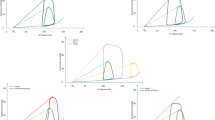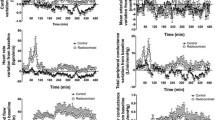Abstract
Introduction
Pneumoperitoneum is associated with a well-described decrease in renal blood flow, but it remains unclear whether a decrease in cardiac preload is responsible. Our aim was to characterize the relationship between cardiac preload and renal perfusion during pneumoperitoneum.
Methods
Eleven pigs were submitted to three 30 minute study periods: 1) Baseline (n=11): no interventions, 2) Pneumoperitoneum (n=11): 12 mmHg CO2 pneumoperitoneum, 3) Preload Reduction: pneumoperitoneum and nitroglycerin infusion (n=8); or pneumoperitoneum and hemorrhage to a mean arterial pressure (MAP) of 40 mmHg (n=3). Echocardiographic measurements of left ventricular end-diastolic diameter (LVEDD) were used as an index of preload. Renal cortical perfusion (RCP) was measured using laser doppler flowmetry.
Results
LVEDD decreased from 4.2 ± 0.5 to 4.1 ± 0.6 cm (p=0.02) with pneumoperitoneum and then to 4.0 ± 0.5 cm (p=0.03) with the addition of nitroglycerin. There was no statistically significant change in RCP with pneumoperitoneum (33.5 ± 8.4 to 28.5 ± 8.4 ml/min/100g tissue, p=0.2), but it decreased to 18.5 ± 11.3 ml/min/100g tissue (p=0.001) with the addition of nitroglycerin. The correlation between RCP and LVEDD was weak (0.35, p=0.003), whereas correlation between RCP and MAP was superior (R=0.59, p<0.0001).
Conclusions
While decreasing preload under extreme lab conditions also decreases RCP, simply creating a pneumoperitoneum of 12 mmHg does not. The decrease in renal blood flow associated with pneumoperitoneum is likely not solely a function of preload.



Similar content being viewed by others
References
Atkins BZ, Silvestry SC, Davis JW, Kisslo JA, Glower DD, Jr. (1999) Means for load variation during echocardiographic assessment of the frank-starling relationship. J Am Soc of Echocardiogr 12: 792–800
Chiu AW, Azadzoi KM, Hatzichristou DG, Siroky MB, Krane RJ, Babayan RK (1994) Effects of intra-abdominal pressure on renal tissue perfusion during laparoscopy. J Endourol 8: 99–103
Chiu AW, Chang LS, Birkett DH, Babayan RK (1995) The impact of pneumoperitoneum, pneumoretroperitoneum, and gasless laparoscopy on the systemic and renal hemodynamics. J Am Coll Surg 181: 397–406
Chiu AW, Chang LS, Birkett DH, Babayan RK (1996) A porcine model for renal hemodynamic study during laparoscopy. J Surg Res 60: 61–68
Cunningham AJ, Turner J, Rosenbaum S, Rafferty T (1993) Transoesophageal echocardiographic assessment of haemodynamic function during laparoscopic cholecystectomy. Br J Anaesth 70: 621–625
D’Angelo AJ, Kline RG, Chen MH, Halpern VJ, Cohen JR (1997) Utility of transesophageal echocardiography and pulmonary artery catheterization during laparoscopic assisted abdominal aortic aneurysm repair. Surg Endosc 11: 1099–1101
Dalibon N, Schlumberger S, Saada M, Fischler M, Riou B (1999) Haemodynamic assessment of hypovolaemia under general anaesthesia in pigs submitted to graded haemorrhage and retransfusion. Br J Anaesth 82: 97–103
Dorsay DA, Greene FL, Baysinger CL (1995) Hemodynamic changes during laparoscopic cholecystectomy monitored with transesophageal echocardiography. Surg Endosc 9: 128–133
Dunn MD, McDougall EM (2000) Renal physiology. Laparoscopic considerations. Urol Clin North Am 27: 609–614
Feldman LS, Anidjar M, Metrakos P, Stanbridge D, Fried GM, Carli F (2004) Optimization of cardiac preload during laparoscopic donor nephrectomy: A preliminary study of central venous pressure versus esophageal doppler monitoring. Surg Endosc 18: 412–416
Flowers JL, Jacobs S, Cho E, Morton A, Rosenberger WF, Evans D, Imbembo AL, Bartlett ST (1997) Comparison of open and laparoscopic live donor nephrectomy. Ann Surg 226: 483–489
Gannedahl P, Odeberg S, Brodin LA, Sollevi A (1996) Effects of posture and pneumoperitoneum during anaesthesia on the indices of left ventricular filling. Acta Anaesthesiol Scand 40: 160–166
Haber HL, Simek CL, Bergin JD, Sadun A, Gimple LW, Powers ER, Feldman MD (1993) Bolus intravenous nitroglycerin predominantly reduces afterload in patients with excessive arterial elastance. J Am Coll Cardiol 22: 251–257
Hamilton BD, Chow GK, Inman SR, Stowe NT, Winfield HN (1998) Increased intra–abdominal pressure during pneumoperitoneum stimulates endothelin release in a canine model. J Endourol 12: 193–197
Harman PK, Kron IL, McLachlan HD, Freedlender AE, Nolan SP (1982) Elevated intra–abdominal pressure and renal function. Ann Surg 196: 594–597
Hashimoto S, Hashikura Y, Munakata Y, Kawasaki S, Makuuchi M, Hayashi K, Yanagisawa K, Numata M (1993) Changes in the cardiovascular and respiratory systems during laparoscopic cholecystectomy. J Laparoendosc Surg 3: 535–539
Hazebroek EJ, de Vos tot Nederveen Cappel R, Gommers D, van Gelder T, Weimar W, Steyerberg EW, Bonjer HJ, JN IJ (2002) Antidiuretic hormone release during laparoscopic donor nephrectomy. Arch Surg 137: 600–604
Hirvonen EA, Nuutinen LS, Vuolteenaho O (1997) Hormonal responses and cardiac filling pressures in head-up or head-down position and pneumoperitoneum in patients undergoing operative laparoscopy. Br J Anaesth 78: 128–133
Joris JL, Noirot DP, Legrand MJ, Jacquet NJ, Lamy ML (1993) Hemodynamic changes during laparoscopic cholecystectomy. Anesth Analg 76: 1067–1071
Junghans T, Bohm B, Grundel K, Schwenk W, Muller JM (1997) Does pneumoperitoneum with different gases, body positions, and intraperitoneal pressures influence renal and hepatic blood flow? Surgery 121: 206–211
Larsen JF, Svendsen FM, Pedersen V (2004) Randomized clinical trial of the effect of pneumoperitoneum on cardiac function and haemodynamics during laparoscopic cholecystectomy. Br J Surg 91: 848–854
Lindberg F, Bergqvist D, Bjorck M, Rasmussen I (2003) Renal hemodynamics during carbon dioxide pneumoperitoneum: An experimental study in pigs. Surg Endosc 17: 480–484
London ET, Ho HS, Neuhaus AM, Wolfe BM, Rudich SM, Perez RV (2000) Effect of intravascular volume expansion on renal function during prolonged co2 pneumoperitoneum. Ann Surg 231: 195–201
Marathe US, Lilly RE, Silvestry SC, Schauer PR, Davis JW, Pappas TN, Glower DD (1996) Alterations in hemodynamics and left ventricular contractility during carbon dioxide pneumoperitoneum. Surg Endosc 10: 974–978
McDougall EM, Monk TG, Wolf JS, Jr., Hicks M, Clayman RV, Gardner S, Humphrey PA, Sharp T, Martin K (1996) The effect of prolonged pneumoperitoneum on renal function in an animal model. J Am Coll Surg 182: 317–328
McLaughlin JG, Scheeres DE, Dean RJ, Bonnell BW (1995) The adverse hemodynamic effects of laparoscopic cholecystectomy. Surg Endosc 9: 121–124
Mikami O, Fujise K, Matsumoto S, Shingu K, Ashida M, Matsuda T (1998) High intra-abdominal pressure increases plasma catecholamine concentrations during pneumoperitoneum for laparoscopic procedures. Arch Surg 133: 39–43
Myre K, Buanes T, Smith G, Stokland O (1997) Simultaneous hemodynamic and echocardiographic changes during abdominal gas insufflation. Surg Laparosc Endosc 7: 415–419
O’Malley C, Cunningham AJ (2001) Physiologic changes during laparoscopy. Anesthesiol Clin North Am 19: 1–19
Ortega AE, Richman MF, Hernandez M, Peters JH, Anthone GJ, Azen S, Beart RW, Jr. (1996) Inferior vena caval blood flow and cardiac hemodynamics during carbon dioxide pneumoperitoneum. Surg Endosc 10: 920–924
Radovancevic B, Eichstaedt HC, Tamez D, Patel V, Eya K, Nolden LK, Byler D, Cohen D, Frazier OH (2003) Prolonged controlled hemorrhagic shock in a swine model: Is there a role for mechanical circulatory assistance? ASAIO J 49: 721–726
Razvi HA, Fields D, Vargas JC, Vaughan ED, Jr., Vukasin A, Sosa RE (1996) Oliguria during laparoscopic surgery: Evidence for direct renal parenchymal compression as an etiologic factor. J Endourol 10: 1–4
Richard L, Bures E, Lacoste L, Declerck A, Carretier M, Debaene B, Fusciardi J (2002) Pigs are not a reliable experimental model in the study of the haemodynamic and respiratory effects of co2 pneumoperitoneum. Acta Anaesthesiol Scand 46: 74–79
Rist M, Hemmerling TM, Rauh R, Siebzehnrubl E, Jacobi KE (2001) Influence of pneumoperitoneum and patient positioning on preload and splanchnic blood volume in laparoscopic surgery of the lower abdomen. J Clin Anesth 13: 244–249
Sinclair S, Singer M (1997) Intraoperative intravascular volume optimisation and length of hospital stay after repair of proximal femoral fracture: Randomised control trial. Br Med J 315: 909–912
Zuckerman R, Gold M, Jenkins P, Rauscher LA, Jones M, Heneghan S (2001) The effects of pneumoperitoneum and patient position on hemodynamics during laparoscopic cholecystectomy. Surg Endosc 15: 562–565
Author information
Authors and Affiliations
Corresponding author
Rights and permissions
About this article
Cite this article
Bergman, S., Nutting, A., Feldman, L.S. et al. Elucidating the relationship between cardiac preload and renal perfusion under pneumoperitoneum. Surg Endosc 20, 794–800 (2006). https://doi.org/10.1007/s00464-005-0086-9
Received:
Accepted:
Published:
Issue Date:
DOI: https://doi.org/10.1007/s00464-005-0086-9




